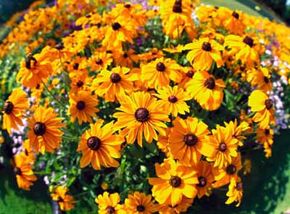Yellow coneflower, or black-eyed Susan, is -- like all the members of this genus -- a native American wildflower. The genus for coneflowers is named in honor of Olaf Rudbeck and his son, both professors of botany.
Advertisement
Description of yellow coneflower, perennial black-eyed Susan: Coneflowers have hairy, 2- to 3-foot stems with simple, saw-toothed edges. They bear daisies with yellow ray flowers, slightly orange at the base, and purple-brown disk flowers, blooming in July and on to frost. Ease of care: Easy.
Growing yellow coneflower, perennial black-eyed Susan: Although best with a good, moist soil, orange coneflowers will adapt to any good garden soil that is not too dry or too wet, in full sun. Divide plants every three years.
Propagating yellow coneflower, perennial black-eyed Susan: By division or by seed.
Uses for yellow coneflower, perennial black-eyed Susan: Great flowers for the wild garden or for naturalizing in the meadow garden, Goldsturm is best for the formal bed or border and should be planted in drifts. These flowers are perfect when used in combination with the variegated ornamental grasses. They are also excellent for cutting.
Yellow coneflower, perennial black-eyed Susan related species: Rudbeckia laciniata, or the green-headed coneflower, is valuable for a wild garden. Goldquelle or, as it's sometimes called, Gold Drop has big, double flowers on 24- to 30-inch stems.
Yellow coneflower, perennial black-eyed Susan related varieties: Goldsturm is the plant usually offered by nurseries. About 24 inches high, the golden-yellow flowers bloom profusely in July and August. Golden Glow is found in old-fashioned gardens, with its moplike golden heads on 6-foot stems.
Scientific name for yellow coneflower, perennial black-eyed Susan: Rudbeckia fulgida
Advertisement
